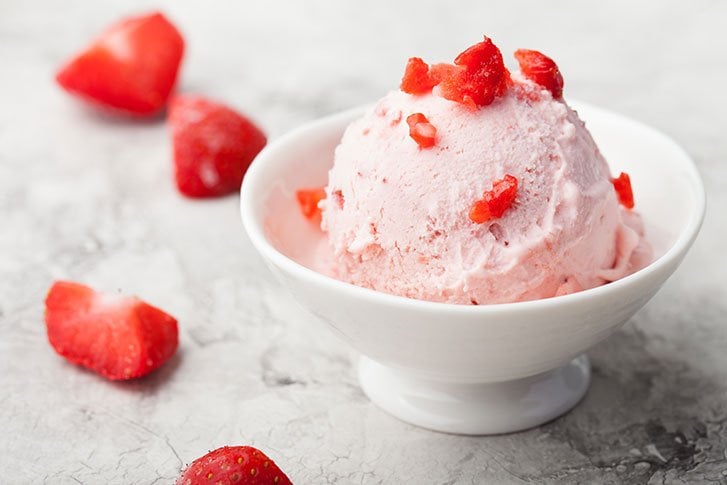Ice Cream

“Life is like an ice cream; enjoy it before it melts.”
– Unknown
July is National Ice Cream Month, so designated by President Ronald Reagan back in 1984. At the same time, he also declared that the third Sunday in July would thereafter be known as National Ice Cream Day.
Ice cream in some form has been around for centuries, quite possibly since as far back as 200 B.C. It likely came into being because someone lost to history decided that adding some sort of flavoring – fruit juice, honey, or nectar – to mountain snow would make for a refreshing treat, especially in hot climates. Some early aficionados of this primitive Sno-Cone were Alexander the Great, King Solomon, and Nero Claudius Caesar, who famously sent runners up into the hills to gather snow for this purpose. (Which would seem to have been a fairly stressful job, as they would have needed to return with it before it melted.)
The Italian court must have been thrilled when Marco Polo arrived from the Far East bearing the recipe for a concoction very like sherbet, and several centuries later, this evolved into what we now know as ice cream (although the English referred to it as “cream ice”). Fans included Catherine de Medici, who popularized it in France, and Charles I. The first Paris café, Procope, introduced a recipe that included milk, butter, cream, and eggs, and by the 1660s, ice cream had quickly caught on with the general public. According to Buzzfeed, the first known ice cream recipe was jotted down by a Lady Anne Fanshawe in 1665.
How did ice cream make it to America, and when? According to the International Dairy Foods Association (who would certainly know!), the first mention of it on our side of the pond was in “a letter written in 1744 by a guest of Maryland Governor William Bladen,” and it is believed to have been brought to our shores by Quaker colonists shortly before that. “The first advertisement for ice cream in this country,” again per the IDFA, “appeared in the New York Gazette on May 12, 1777, when confectioner Philip Lenzi announced that ice cream was available "almost every day." Records kept by a Chatham Street, New York, merchant show that President George Washington spent approximately $200 for ice cream during the summer of 1790…[and] President Thomas Jefferson was said to have a favorite 18-step recipe for an ice cream delicacy that resembled a modern-day Baked Alaska.” Also, Benjamin Franklin is rumored to have enjoyed ice cream on a regular basis.
How about everyday Americans? The rest of us can thank Baltimore milk dealer Jacob Fussell, who in 1851 pioneered a method for mass-manufacturing ice cream; and the invention of insulated ice houses and motorized delivery vehicles for making it accessible to the masses.
In honor of National Ice Cream Month, here is some fun trivia. Dish up a big scoop of Rocky Road and read on…
- There are strict government regulations that dictate what can legally be called “ice cream,” mostly having to do with the ratio of the ingredients to each other and how much cream is added. If a formulation doesn’t fall within the guidelines, it must be labeled a “frozen dairy dessert.” (A bit like real cheese versus “processed cheese food.”)
- Speaking of “frozen dairy,” annual production in the United States totals more than 1.6 billion gallons. It takes almost 6 pounds of whole milk and one pound of cream to make one gallon. The top ingredient in ice cream, though, is air.
- The American state that produces the most ice cream? California! And the U.S. is the top ice cream producer in the world.
- Lactose intolerant? Have food allergies? Need a gluten-free ice cream? Alternatives are plentiful, but be sure to scrutinize the label.
- Useless Daily tells us that the father of modern medicine, Hippocrates, encouraged his Ancient Greek patients to eat ice “as it livens the lifejuices and increases the well-being.”
- The average (or possibly bigger than average!) American consumes about 46 pints of ice cream annually.
- What is the most popular ice cream flavor? If you guessed vanilla, you win! Chocolate is second. However, chocolate syrup is the most sought-after ice cream topping. And speaking of toppings, a syrup version of Hawaiian Punch started out as one, before someone determined that it was better as a beverage. Speaking of unusual ice cream flavors, here are a few more: asparagus, oyster, parmesan, beer, and buckwheat.
- It has been reported that right before he died, Elvis Presley put away six chocolate chip cookies and four scoops of ice cream. What a way to go.
- The ice cream cone came along in 1904, introduced by a waffle maker at the St. Louis World’s Fair who got the inspiration to roll one of his creations into a cone shape when a neighboring ice cream vendor ran out of paper bowls.
- In 1984, Ben & Jerry’s was also the first ice cream purveyor to introduce cookie dough ice cream, from a note left on a suggestion board in their Burlington, Vermont store. Also, Ben & Jerry’s often sent their leftovers to a nearby farm for the hogs, who reportedly turned up their snouts at the Mint Oreo Cookie flavor.
- Are you a fan of soft serve ice cream? Thank British Prime Minister Margaret Thatcher, who was part of a team that developed it.
- The Häagen-Dazs ice cream brand was started by two Americans, who invented the name so it would sound Danish (and presumably, more posh).
- Ever marvel at a gorgeous photo of ice cream in a magazine? Chances are, you’re looking at mashed potatoes, which is popular with food stylists because of its staying power.
- The soda jerk was so named because of the “jerking” motion used to operate the soda draft arm.
- The original flavors in Neapolitan ice cream were cherry, vanilla, and pistachio, as a nod to the Italian flag.
- Finally, in 1986, a candidate for mayor of Carmel by the Sea, California scored an overwhelming victory because of a campaign promise to overturn an ordinance banning the sale of ice cream. Who was he? Actor Clint Eastwood.
By the way, if you want to celebrate National Ice Cream for Breakfast Day, you’ll have to wait until February 4. Mark your calendars!





